Hip Flexor Stretches to Counteract All That Sitting
Got back pain? Tight hip flexors could be to blame. Open them up with these four yoga poses that counterbalance the prolonged hip flexion of sitting for hours.
We’ve got bad news for the desk-sitters out there: All that sedentary time staring at a screen is doing a number on your health. Not only has too much sitting been linked to serious health problems, like obesity and osteoporosis, among others, but it also is a significant contributor to that nagging lower back ache that you’ve been complaining about. But it’s not actually your back that’s the issue: It’s your hip flexors.
While sitting, your hip flexors constantly remain in a flexed position. Over time, sitting too much will cause these muscles to shorten and shrink, limiting your ability to fully straighten the hip when you’re finally upright again. When your hip flexors are too tight, they pull down and forward on the pelvis, which tilts it forward and compresses the lower back. Congratulations, now you have back pain!
So what’s a yogi to do? Yoga, of course. You can use your practice to offset the effects of all that sitting, stretch the hip flexors, relieve associated back pain, and set the stage for a safe practice of intermediate poses like backbends.
See also: 8 Yoga-Based Stretches to Relieve Tight Hips
What exactly are the hip flexor muscles?
Several muscles cross the front of the hip and create hip flexion, pulling the thigh and trunk toward each other, but probably the most important is the iliopsoas. It is actually composed of two muscles, the iliacus and the ever-mysterious psoas, which lie deep in the back of the abdomen.
If you looked at the front of a body with the internal organs removed, you would see the psoas lying alongside the spine, attached to the sides of the lumbar vertebrae. The iliacus originates on the inner bowl of the pelvis. Both muscles cross the floor of the pelvis, emerge at the outer edges of the pubic bones, and finally insert on the inner upper femur (thighbone). Because the muscles are buried so deep, we can’t see or touch them, so it’s easy to understand why there is much confusion about their location and action. But trust us, these muscles are extremely important in building a balanced alignment, ensuring proper joint rotation, and achieving a full muscular range of motion.
If you are standing, the hip flexors lift your leg when you step up on a stool. If you are lying flat on your back, the hip flexors can either lift your leg or lift your torso into a sit-up. In yoga, Navasana (Boat Pose) is especially good at strengthening the iliopsoas because it demands that the muscle isometrically contract to hold up the weight of the legs and torso.
See also: 7 Poses That Help Deepen Your Awareness to Release the Psoas
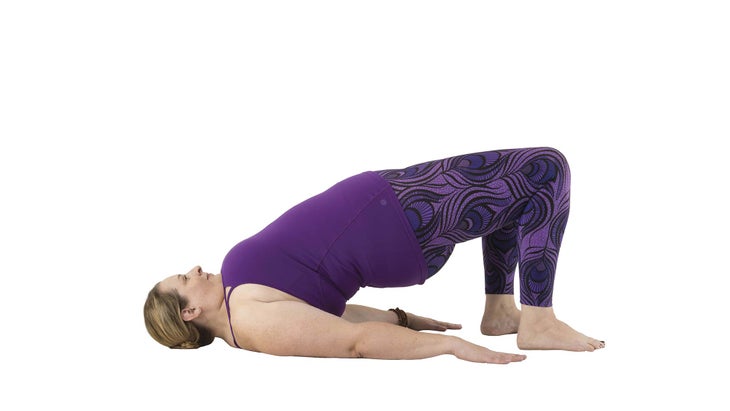
How hip flexors lose flexibility
Most problems with the hip flexors don’t originate in a lack of strength but in a lack of flexibility. To understand how these muscles lose their flexibility, imagine someone with a broken arm, her bent elbow encased in a plaster cast. When the cast is removed after six or eight weeks, the soft tissues around the elbow (muscles, tendons, ligaments, and even skin) will have shortened, and the elbow won’t immediately straighten out. It will take the patient stretching over several weeks to restore the full range of motion. Similarly, if the hip is constantly kept in a flexed position, like sitting, for hours every day, day after day, the hip flexors will shorten and shrink, limiting your ability to fully extend the hip.
If the iliopsoas and other hip flexors are tight, they pull down and forward on the pelvis, which tilts the pelvis forward and compresses the lower back. Picture a man standing with the front of his pelvis tilting forward and his tailbone lifting. To stand upright, he has to overarch his lower back. Anatomically, this is called hyperextension; commonly, it’s called “swayback.” Prolonged standing or sitting in this position increases pressure on the facet joints of the lower spine, which in turn can contribute to arthritis in those joints.
With the best of intentions, yoga students sometimes create a muscle imbalance between the hamstrings and the hip flexors that contributes to an anterior (forward) pelvic tilt. Most yoga practitioners work long and hard to improve their hamstring flexibility but spend much less time stretching their hip flexors. Eventually, the hamstrings lengthen significantly, while the hip flexors improve only slightly. The result: The relatively tighter hip flexors tip the pelvis forward because the relatively longer hamstrings no longer exert an equal counterpull on the sitting bones of the pelvis.
See also: 7 Poses to Release Those Tight Hamstrings
If the hip flexors are tight, the resulting anterior pelvic tilt and lumbar hyperextension will cause problems in many yoga poses, including standing poses like Virabhadrasana II (Warrior Pose II) and Trikonasana (Triangle Pose), in which the primary leg action is opening to the sides instead of flexing forward or extending back.
The real problems begin, however, in poses requiring full extension (straightening) of the hip joint. These poses include backbends such as Setu Bandha Sarvangasana (Bridge Pose) and Urdhva Dhanurasana (Upward-Facing Bow Pose), where both hips are extended, and standing poses like Virabhadrasana I (Warrior Pose I) and Virabhadrasana III (Warrior Pose III), in which the legs open forward and backward (front leg hip flexed, back leg hip extended). In all these poses, tight hip flexors can cause painful compression in the lower back, a fairly common problem in backbends.
See also: 6 Yoga Poses to Help Improve Flexibility
4 yoga poses to effectively stretch your hip flexors
For people in a sedentary society, daily hip flexor stretches are important to help counterbalance the prolonged hip flexion of sitting for hours. They are also an important preparation for backbends, allowing the hips to extend fully so we can avoid compression in the lower back.
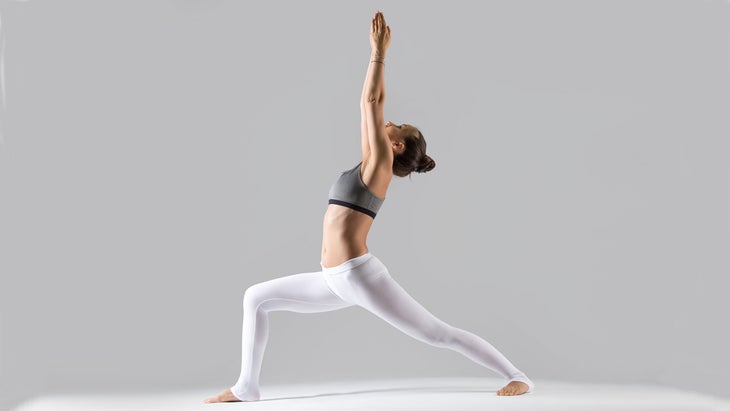
Meet your ASIS in Virabhadrasana I (Warrior I)
If done with proper alignment, Warrior Pose I can be a wonderful hip flexor stretch. Stand with one leg forward and one leg back, ready for Warrior I. Put your fingers on the front pelvis bones: You should be able to feel a small, round protuberance on each side, called the anterior superior iliac spine, or ASIS.
The ASISes are good indicators of the tilt of the pelvis. On the side of the pelvis with the extended hip (the back leg), the iliopsoas will try to pull the pelvis and lumbar spine down and forward into an anterior tilt. To counter this, use your fingers to show the ASISes how to lift up. Hold this posterior tilt as you bend the front knee, keeping the back knee straight and the back heel grounded. Feel the iliopsoas lengthen and visualize the spine lifting out of the pelvis.
You can also work with the pelvic alignment in Warrior I by bringing your awareness to the lower back and back of the pelvis. Hold or tie a belt around your waist. As you move into Warrior I, don’t let your ASISes drop down and forward and your tailbone lift up.
Instead, move your back waist into the belt, move your tailbone down away from the belt, and lift the spine up out of the belt. The belt becomes a point of orientation to help you align your pelvis and get a deep iliopsoas stretch.
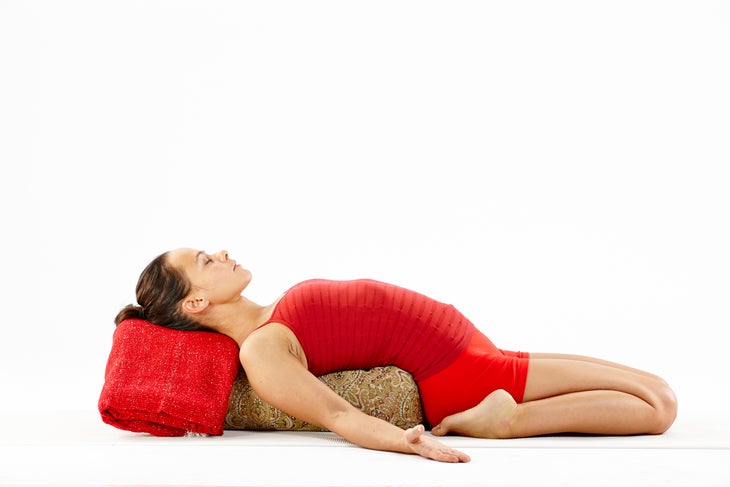
Stretch your rectus femoris in Supta Virasana (Reclining Hero Pose)
Another muscle, the rectus femoris, can also limit hip flexion and cause problems in yoga poses. Part of the quadriceps muscle on the front of the thigh, it originates near the ASIS, runs down the center of the thigh, and inserts on the shinbone (tibia) just below the knee. When the rectus femoris contracts and shortens, it not only extends or straightens the knee, it also flexes the hip.
To stretch the rectus femoris, we need a pose that flexes the knee and extends the hip, like Supta Virasana (Reclining Hero Pose). As you sit down between your heels and lie back in this pose, the rectus femoris lengthens.
If it isn’t long enough to allow the pelvis to tilt all the way back, compression and discomfort in the lower back can occur. To stretch the rectus femoris without compressing the lower back, place a bolster or folded blankets comfortably under your back in Supta Virasana, with enough height to keep some length in the lower back.
See also Got Tight Quads? Yes, You Can Still Enjoy Supta Virasana
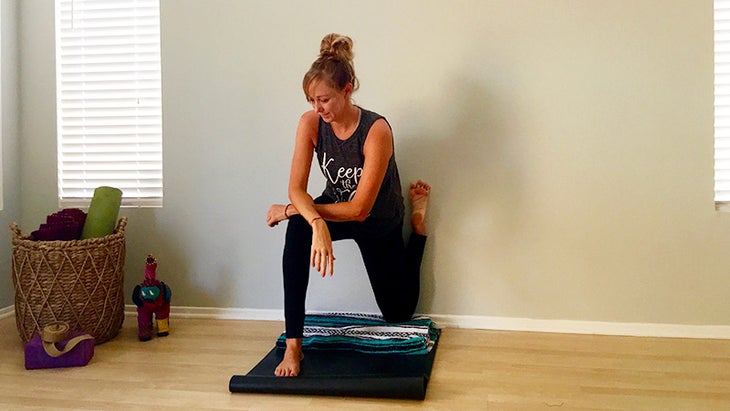
Embrace intensity in King Arthur’s Pose
Alternately, try King Arthur’s Pose: Starting on hands and knees with your feet near a wall, put your right shin straight up the wall and bring your left foot forward so it’s under the left knee. Place your hands on your knee and lift your spine straight up while taking your tailbone down. You should feel a strong stretch on the front part of your thigh.
See also: Do Less, Relax More: Legs-Up-the-Wall Pose
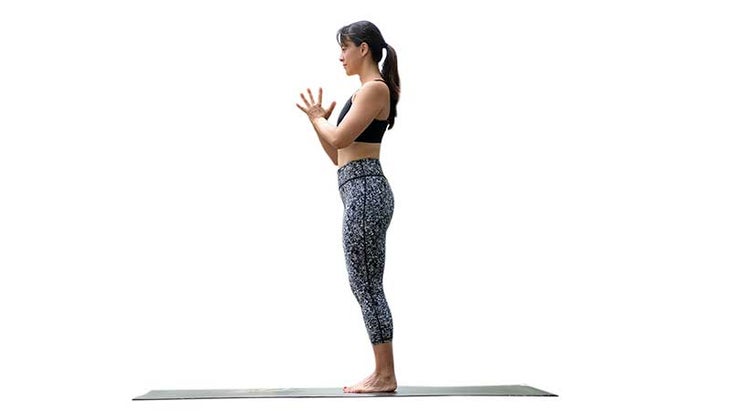
Develop awareness of your pelvic tilt in Tadasana (Mountain Pose)
If you tend to stand with a “swayback,” developing awareness of the opening at the front of your hips is especially important. In Tadasana (Mountain Pose), practice lifting the ASISes, moving the tailbone down, and lifting the lumbar spine. Putting a belt around your waist, as you did in Warrior I, may help you increase your awareness of your pelvic alignment in this pose, too.
Often people try to correct a forward tilt of the pelvis by gripping with the abdominal muscles. But besides limiting your breathing and being counterproductive in backbends, gripping the abdominals won’t control the anterior pelvic tilt if you have tight hip flexors—not even in simple standing postures. That’s why it’s so important to make hip flexor stretches part of your daily practice, especially after a long day of sitting. These poses will let you enjoy a new sense of space in your pelvis—and help protect you from compression and pain in your lower back.
Want more? Here are 6 Poses for Tight Hip Flexors
沒有留言:
張貼留言